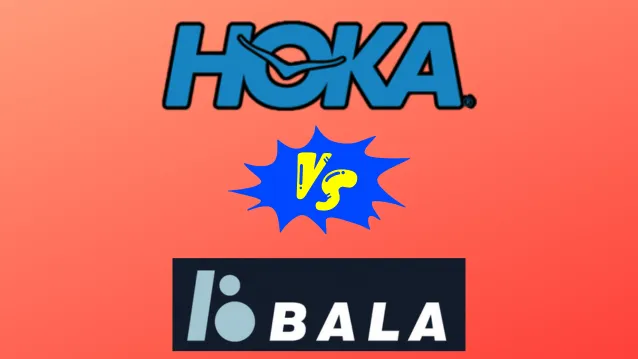Bala and Hoka are two top athletic shoe brands, each with their own unique styles and technologies.
However, for consumers faced with a choice between the two, determining the key differences can be challenging.
This article provides a detailed comparison of Bala against Hoka shoes, including a breakdown of comfort, performance, durability, design, price and more. Keep reading to learn which shoe brand is better for you.
Comparison Table Between Bala And Hoka:
| Features | Bala | Hoka |
|---|---|---|
| Founded In | 2020 | 2009 |
| Comfort & Fit | Flexible, barefoot-like feel | Cushioned, thick midsole |
| Color Options | Limited | Wide variety |
| Durability | Less durable sole | Durable rubber outsole |
| Performance | Better for everyday wear | Optimized for long runs |
| Design & Style | Minimalist, stylish | Bulky, maximalist |
| Popularity | Growing in popularity | Well-established brand |
| Best Selling Model | Bala Twelves | Bondi 7 |
Bala Overview:
As a relative newcomer founded in 2020, Bala shoes feature a minimalist, flexible design.
Their shoes have an ultra-thin sole and knit upper, delivering a barely-there, “barefoot” feel. This allows the foot to move and flex naturally, engaging muscles for better stability.
It was founded by former executives from major athletic brands like Nike, Under Armour, and Adidas. Their goal was to create the perfect everyday shoe that combined comfort, style, and performance.
Bala uses proprietary Float Foam in the midsole that provides cushioning while maintaining flexibility. The foam is lightweight so it doesn’t add bulk.
The stretchy knit upper material conforms to the shape of the foot for a secure yet non-restrictive fit. It allows for plenty of airflow to keep feet cool and dry.
Reviews suggest Bala shoes provide enough cushion and arch support for all-day wear without sacrificing freedom of motion. This makes them popular among nurses, teachers, and others on their feet for long hours.
The minimalist, foot-hugging design helps improve posture and joint alignment while engaging foot muscles more than traditional shoes. This can aid people who suffer from foot pain or plantar fasciitis.
While not explicitly designed for training, the barely-there sole does offer sensory feedback for activities like yoga, Pilates and light running. Bala emphasizes versatility, comfort and seamless transitions – from work to workout to everyday wear.
The sleek, modern aesthetic blends athleisure and minimalist design, attracting fans who want both style and comfort.
Hoka Overview:
Founded in 2009 by Nicolas Mermoud and Jean-Luc Diard, Hoka One One burst onto the scene with their super thick midsoles, aiming to provide maximum cushioning for runners.

Initially, their oversized design was polarizing. But as more runners experienced the plush ride, Hoka gained a cult following among ultramarathoners and trail runners.
Hoka remains focused on cushioning and stability to create a smooth, comfortable run. Signature technologies like the Meta-Rocker outsole encourage a natural gait cycle and transition. The roomy toe box allows your feet to splay and relax over long miles.
For runners who struggle with joint pain and hard impact, Hoka’s pillow-like foam brings sweet relief. The soft landings and energetic rebound make each stride feel effortless. It’s easy to see why Hokas have a reputation for comfort.
Hokas aren’t the most flexible shoe due to the higher platform. And the bulky silhouette isn’t for everyone. But for runners craving a cushy feel, Hoka delivers plush shoes that can go the distance in blissful comfort.
Major Differences Between The Brands:
In this section, we will evaluate Bala and Hoka based on their performance, target market, and pricing to see who excels.
1) Comfort and Fit
When it comes to comfort and fit, these two brands take very different approaches. Bala prioritizes flexibility and a barefoot feel while Hoka is all about plush cushioning.
Bala shoes are designed to be barely there, moving and flexing with your foot for a natural experience. The thin sole and knit upper provide just enough structure while allowing your foot to move freely.
In contrast, Hoka packs on the cushioning with its signature thick midsole and structured upper. This delivers exceptional shock absorption but sacrifices ground feel.
Also Check Out: Hoka VS Reebok: Which Is Better?
2) Durability and Performance
Durability and performance are intertwined when comparing shoes. From what I’ve observed, Hoka shoes are more durable overall. This is likely due to their thick rubber outsole and sturdier foam midsole.
Bala’s thin, flexible sole doesn’t seem to hold up as well with heavy use. However, Bala isn’t designed for intense training which can break down shoes quicker.
For everyday wear, Bala should hold up fine. Now for performance – Hoka shoes excel at long-distance runs where bounce, cushioning, and impact protection are essential. Their rigid shape helps guide your foot too.
Bala promotes natural movement so isn’t ideal for speed work or trails. But their flexible sole offers plenty of ground feedback for shorter runs. Ultimately, Hokas win for hardcore training while Bala suits casual everyday wear.
Also Check Out: Hoka VS Orthofeet: Which Is Better?
3) Price
When comparing the price of Bala and Hoka shoes, Hoka is the more expensive option on average. Their shoes typically range from $120-$180+. Meanwhile, Bala shoes fall between $95-$100 generally.
As a newer brand, Bala seems to have more budget-friendly pricing. However, shoes from both brands can be found at lower prices if you shop sales or buy last year’s models.
For the extra cushioning and proven performance, Hoka fans don’t mind paying a little extra. But if you’re seeking an affordable, everyday shoe then Bala gives you comfort without the high price tag.
Also Check Out: Hoka VS Ryka: Which Is Better?
4) Design and Style
If you like a minimalist, sleek athletic shoe then Bala is probably more your style. Their shoes have an understated design with slim silhouettes and monochrome colorways.
Hoka, on the other hand, is known for its maximalist, chunky style. Their tall midsoles and bold colors make a statement but aren’t for everyone.
Bala’s shoes feature stretchy knit uppers that contour to your feet. Meanwhile, Hokas have structured mesh uppers designed to provide stability and support.
While both brands offer classic black and white options, Hoka isn’t afraid to get wild with bright colors and patterns. So in terms of aesthetics, Bala leans subtle while Hoka embraces the bulky maximalist look.
Also Check Out: Hoka VS Under Armour: Which Is Better?
5) Popularity
When it comes to popularity, Hoka edges out newcomer Bala. As an established athletic brand, Hoka has already built a loyal following among runners. The cushioning technology and consistent performance make them a top choice for marathons.
While not yet a household name, Bala is quickly gaining fans with their barefoot-style shoes. Nurses and other professionals on their feet all day love Bala for the comfort. And the minimalist, knit design has broad appeal both in and out of the gym.
While I think Bala will continue growing, Hoka remains the more well-known and popular brand – at least for now!
Also Check Out: Hoka VS New Balance: Which Is Better For You?
6) Target Market
Both Bala and Hoka target active, health-conscious consumers but cater to different needs. Hoka dominates the long-distance running market; their extra cushioning provides the comfort and support marathoners need. They also appeal to runners recovering from injury who need that plush, protective ride.
Bala fills the need for an effortlessly comfortable, everyday shoe whether you’re a busy mom, nurse or just want all-day wearability.
Their barefoot design attracts people interested in foot health and minimalist shoes. However, hardcore gym enthusiasts may still prefer a traditional training sneaker. At the end of the day, Hoka focuses on serious runners while Bala carves out that comfortable, versatile niche for the wellness-minded.
Final Verdict:
In summary, Hoka and Bala take vastly different approaches to athletic footwear. Hoka prioritizes maximum cushioning for long mileage and injury prevention. Bala promotes natural motion in a barely-there package better for casual use than hardcore training.
For serious runners, Hoka is likely the better choice while casual athleisure fans may prefer Bala’s barefoot style and aesthetic.
Both brands offer quality shoes with advanced technologies at their core. So, it ultimately comes down to the wearer’s specific needs and preferences.


